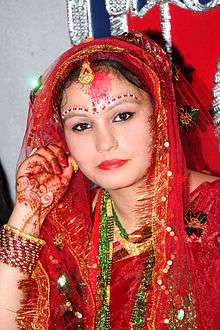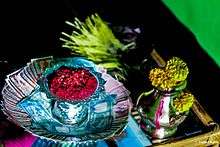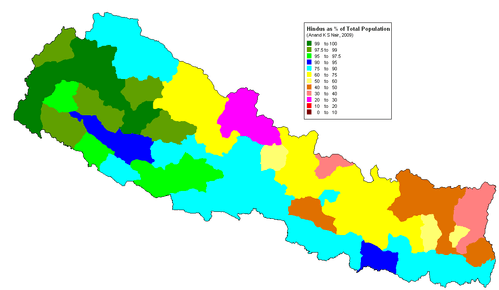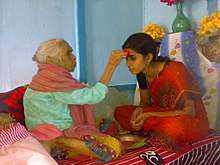Hinduism in Nepal
Hinduism is the main and largest religion of Nepal. The Constitution of Nepal has established a call for the protection of this age-old religion throughout the country.In 2007 the country declares itself that it is a secular country while some special privileges were also given to Hinduism. According to the 2011 census, the Hindu population in Nepal is estimated to be around 22,493,649 including native kirat Mundhum, Prakriti (nature worshippers) and Bon which have deep roots and strong connection with Sanatan Dharma and all together accounts for at least 85% of country's population. The national calendar of Nepal, Vikram Samvat, is a solar Hindu calendar essentially the same to that widespread in North India as a religious calendar, and is based on Hindu units of time.
| Year | Pop. | ±% |
|---|---|---|
| 1952 | 7,318,392 | — |
| 1961 | 8,254,403 | +12.8% |
| 1971 | 10,330,009 | +25.1% |
| 1981 | 13,445,787 | +30.2% |
| 1991 | 15,996,653 | +19.0% |
| 2001 | 18,330,121 | +14.6% |
| 2011 | 22,493,649 | +22.7% |
| Source: 1952-2001[1] | ||

The geographical distribution of religious groups revealed a preponderance of Hindus, accounting for at least 90 percent of the population in every region. Among Tibeto-Burman-speaking communities in Nepal, those most influenced by Hinduism are the Magars, Sunwar, and Rai people.[2]
(Percentage of Hindus in Nepal by decades)
| Year | Percent | Increase |
|---|---|---|
| 1952/54 | 88.87% | - |
| 1961 | 87.69% | -1.18% |
| 1971 | 89.39% | +1.70% |
| 1981 | 89.50% | +0.11% |
| 1991 | 86.51% | -2.99% |
| 2001 | 80.62% | -5.89% |
| 2011 | 85% | +4.38% |
Hindu foundation of the Kingdom of Nepal
Historians and local traditions say that a Hindu sage named "Ne" established himself in the valley of Kathmandu during prehistoric times, and that the word "Nepal" means the place protected ("pala" in Sanskrit) by the sage Ne.[3] He performed religious ceremonies at Teku, the confluence of the Bagmati and Bishnumati rivers.[4] According to legends, he selected a pious cowherd to be the first of the many kings of the Gopala dynasty.[3] These rulers are said to have ruled Nepal for over 500 years.[5] He selected Bhuktaman to be the first king in the line of the Gopal (Cowherd) dynasty.[4] The Gopal dynasty ruled for 621 years. Yakshya Gupta was the last king of this dynasty.
According to Skanda Purana, a rishi called "Ne" or "Nemuni" used to live in Himalaya.[6] In the Pashupati Purana, he is mentioned as a saint and a protector.[7] He is said to have practiced penance at the Bagmati and Kesavati rivers[8] and to have taught his doctrines there too.[3]
Hinduization by rulers
Newar-Maithil rulers
According to various historical sources, even though the presence of varna and caste had been known as an element in the social structure of the Kathmandu Valley since the Licchavi period (c., 3rd century CE), majority of the residents of the Nepal Valley were for the first time codified into a written code only in the 14th century in the Nepalarastrasastra by the Maithil–origin king Jayasthithi Malla (1354–1395 A.D.).[9] Jayasthithi Malla, with the aid of five Kānyakubja and Maithil Brahmins whom he invited from the Indian plains, divided the population of the valley into each of four major classes (varna)—Brahmin, Kshatriya, Vaishya, Shudra—derived from the ancient Hindu text Manusmriti and based on individual's occupational roles.[10] The four classes varna encompassed a total of 64 castes jat within it, with the Shudras being further divided into 36 sub-castes.
Khas rulers

After the Gorkhali conquest of Kathmandu valley, King Prithvi Narayan Shah expelled the Christian Capuchin missionaries from Patan and revisioned Nepal as Asal Hindustan (Real Land of Hindus).[11] The Tagadharis, thread wearing Hindus of higher categorization, enjoyed the privileged status in the Nepalese capital and more access to the central power after the Gorkhali King Prithvi Narayan's conquest of Kathmandu valley.[12][13] Since then Hinduisation became the significant policy of the Kingdom of Nepal.[11]
The Nepali civil code Muluki Ain was commissioned by Jung Bahadur Rana after his European tour and enacted in 1854. It was rooted in traditional Hindu Law and codified social practices for several centuries in Nepal.[14] The law also comprised Prāyaścitta (avoidance and removal of sin) and Ācāra (the customary law of different castes and communities). It was an attempt to include the entire Hindu as well as the non-Hindu population of Nepal of that time into a single hierarchic civic code from the perspective of the Khas rulers.[15][16]
Hindu symbolism of Nepal
The pennant is an important Hindu flag that is help atop Hindu temples.
It is believed that Lord Vishnu had organized the Nepali people and given them their flag, with the sun and moon as emblems on it.[17] In a Hindu Purana, it is written that it was Lord Shiva who handed the flag to Lord Vishnu, and then Lord Vishnu to Lord Indra, for the purpose for battling demons.[18]
List of festivals in Nepal

- Dashain
- Tihar
- Janai Purnima, Rakshya Bandhan, Khumbeshwor Mela Patan
- Shree Krishna Janmastami
- Maghe Sankranti
- Shree Panchami
- Maha Shivaratri
- Fagu Purnima (Holi)
- Matatirtha Aunsi (Nepali equivalent of Mother's Day)
- Gokarna Aunsi (Nepali equivalent of Father's Day)
- Buddha Jayanti (birthday of the Budhha, but also celebrated by Hindu people as great harmony exists between Hindus and Buddhists in Nepal)
- Ghanta Karna Chaturdasi
- Gaijatra
- Teej
- Indrajatra (in Kathmandu)
- Chhath
- Ghode Jatra
- Shree Ram Nawami
- Vivaha Panchami
- Bagh Jatra
- Bhairav Kumari Jatra
- Chaite Dashain
- Gaura Parva
- Gunla
- Guru Purnima
- Rato Macchendranath Jatra
- Mani Rimdu
- Mata-yaa
- Neel Barahi Pyakhan
- Rath Yatra
- Tamu Dhee
- Tansen Jatra
- Taya Macha
- Yomari Punhi
Hindu-Buddhist syncretism
There has traditionally been a great deal of intermingling of Hindu and Buddhist beliefs. Many people regarded as Hindus in the 1981 census could also in some senses be called Buddhists. Hindus long have worshipped at Buddhist temples and Buddhists at Hindu temples. The reason for this is that both Hinduism and Buddhism have common roots, and over most of their history have not been seen as separate communions, but rather rival tendencies within a shared religious tradition. Because of such dual faith practices (or mutual respect), the differences between Hindus and Buddhists have been very subtle and academic in nature; Hindus and Buddhists have never engaged in any religious conflicts for past millennia. There are many temples where both Hindus and Buddhists can enter and worship.
Demographics
Hindu population by ethnic group

The figures are based on the 2011 Nepal census.[19] NEG denotes newly listed ethnic group, for which 2001 Nepal census figures are not available.
| Caste | Hindu change | Race | Hindus 2001 | Hindus 2011 | Pop 2011 |
|---|---|---|---|---|---|
| Chhetri/Kshetri | -0.23% | Khas | 99.48% | 99.25% | 4,398,053 |
| Brahmin (Hill)/Bahun | -0.12% | Khas | 99.68% | 99.56% | 3,226,903 |
| Magar | +4.36% | Sino/Tibetan | 74.60% | 78.96% | 1,887,733 |
| Tharu | -3.67% | Adivasi | 97.63% | 93.96% | 1,737,470 |
| Tamang | +1.19% | Sino/Tibetan | 7.69% | 8.88% | 1,539,830 |
| Newar | +3.25% | Sino/Tibetan and Indic Aryan | 84.13% | 87.38% | 1,321,933 |
| Musalman | -2.19% | Muslim | 2.19% | 0.00% | 1,164,255 |
| Kami | -0.34% | Dalit | 96.69% | 96.35% | 1,258,554 |
| Yadav | -0.09% | Terai/Low | 99.78% | 99.69% | 1,054,458 |
| Rai | +2.53% | Sino/Tibetan | 25.00% | 27.53% | 620,004 |
| Gurung | +3.43% | Sino/Tibetan | 28.75% | 32.18% | 522,641 |
| Damai/Dholi | -1.22% | Dalit | 97.81% | 96.59% | 472,862 |
| Limbu | +3.02% | Sino/Tibetan | 11.32% | 14.34% | 387,300 |
| Thakuri | -0.09% | Khas | 99.40% | 99.31% | 425,623 |
| Sarki | -2.44% | Dalit | 97.90% | 95.46% | 374,816 |
| Teli | 0.39% | Terai/Low | 99.19% | 99.58% | 369,688 |
| Chamar | 0.70% | Dalit | 98.85% | 99.55% | 335,893 |
| Koiri | -0.06% | Terai/Low | 99.77% | 99.71% | 306,393 |
| Kurmi | 0.00% | Terai/Low | 99.84% | 99.84% | 231,129 |
| Sanyasi | -0.16% | Khas | 99.21% | 99.05% | 227,822 |
| Dhanuk | -0.15% | Terai/Low | 99.75% | 99.60% | 219,808 |
| Musahar | +0.58% | Dalit | 98.52% | 99.10% | 234,490 |
| Dusadh | +0.20% | Dalit | 99.47% | 99.67% | 208,910 |
| Sherpa | -6.26% | Sino/Tibetan | 6.26% | 0.00% | 112,946 |
| Sonar | +1.29% | Terai/Low | 98.20% | 99.49% | 64,335 |
| Kewat | +0.17% | Terai/Low | 99.58% | 99.75% | 153,772 |
| Brahman(Terai) | -0.05% | Terai High | 99.58% | 99.53% | 134,106 |
| Kathbaniyan | +0.36% | Terai High | 99.32% | 99.68% | 138,637 |
| Gharti/Bhujel | +1.10% | Sino/Tibetan | 96.50% | 97.60% | 118,650 |
| Mallaha | +0.63% | Terai/Low | 99.13% | 99.76% | 173,261 |
| Kalwar | +0.08% | Terai/Low | 99.69% | 99.77% | 128,232 |
| Kumal | -0.17% | Sino/Tibetan | 98.42% | 98.25% | 121,196 |
| Hajam/Thakur | +0.07% | Terai/Low | 99.59% | 99.66% | 117,758 |
| Kanu | -0.16% | Terai/Low | 99.89% | 99.73% | 125,184 |
| Rajbansi | +13.75% | Adivasi | 85.15% | 98.90% | 115,242 |
| Sunuwar | +12.79% | Sino/Tibetan | 79.50% | 92.29% | 55,712 |
| Sudhi | -0.18% | Terai/Low | 99.67% | 99.49% | 93,115 |
| Lohar | -0.24% | Terai/Low | 99.78% | 99.54% | 101,421 |
| Tatma | -0.29% | Dalit | 99.79% | 99.50% | 104,865 |
| Khatwe | +0.15% | Dalit | 99.45% | 99.60% | 100,921 |
| Dhobi | +0.27% | Dalit | 99.45% | 99.72% | 109,079 |
| Majhi | +0.31% | Sino/Tibetan | 81.67% | 81.98% | 83,727 |
| Nuniya | +0.48% | Terai/Low | 99.34% | 99.82% | 70,540 |
| Kumhar | +0.39% | Terai/Low | 99.19% | 99.58% | 62,399 |
| Danuwar | -15.60% | Sino/Tibetan | 99.26% | 83.66% | 84,115 |
| Chepang | -5.73% | Sino/Tibetan | 70.23% | 64.50% | 68,399 |
| Haluwai | +0.25% | Terai/Low | 99.38% | 99.63% | 83,869 |
| Rajput | +0.29% | Terai High | 99.32% | 99.61% | 41,972 |
| Kayastha | +0.74% | Terai High | 98.88% | 99.62% | 44,304 |
| Badhaee | +0.07% | Terai/Low | 99.52% | 99.59% | 28,932 |
| Marwadi | -1.53% | Other | 94.88% | 93.35% | 51,443 |
| Santhal | -6.07% | Adivasi | 83.06% | 76.99% | 51,735 |
| Jhangad | -11.29% | Adivasi | 92.79% | 81.50% | 37,424 |
| Bantar/Sardar | +1.31% | Dalit | 97.85% | 99.16% | 55,104 |
| Baraee | -0.10% | Terai/Low | 99.90% | 99.80% | 80,597 |
| Kahar | -0.39% | Terai/Low | 99.88% | 99.49% | 53,159 |
| Gangai | -11.13% | Adivasi | 98.44% | 87.31% | 36,988 |
| Lodh | -1.39% | Terai/Low | 99.82% | 98.43% | 32,837 |
| Rajbhar | +0.25% | Terai/Low | 99.41% | 99.66% | 9,542 |
| Thami | -11.81% | Sino/Tibetan | 55.74% | 43.93% | 28,671 |
| Dhimal | -1.30% | Adivasi | 57.41% | 56.11% | 26,298 |
| Bhote | -37.90% | Sino/Tibetan | 37.90% | 0.00% | 13,397 |
| Bin | -0.10% | Terai/Low | 99.88% | 99.78% | 75,195 |
| Gaderi | -0.03% | Terai/Low | 99.70% | 99.67% | 26,375 |
| Nurang | -98.54% | Sino/Tibetan | 98.54% | 0.00% | 278 |
| Yakkha | -2.67% | Sino/Tibetan | 14.17% | 11.50% | 24,336 |
| Darai | -2.95% | Sino/Tibetan | 97.89% | 94.94% | 16,789 |
| Tajpuriya | +13.05% | Adivasi | 64.15% | 77.20% | 19,213 |
| Thakali | -3.21% | Sino/Tibetan | 33.83% | 30.62% | 13,215 |
| Chidimar | -0.17% | Adivasi | 99.29% | 99.12% | 1,254 |
| Pahari | +12.28% | Sino/Tibetan | 78.90% | 91.18% | 13,615 |
| Mali | -0.11% | Terai/Low | 99.78% | 99.67% | 14,995 |
| Bangali | +2.05% | Other | 97.02% | 99.07% | 26,582 |
| Chhantyal | +64.25% | Sino/Tibetan | 30.78% | 95.03% | 11,810 |
| Dom | -0.05% | Dalit | 99.24% | 99.19% | 13,268 |
| Kamar | +1.89% | Terai/Low | 98.00% | 99.89% | 1,787 |
| Bote | -10.53% | Sino/Tibetan | 98.57% | 88.04% | 10,397 |
| Brahmu | +7.55% | Sino/Tibetan | 72.04% | 79.59% | 8,140 |
| Gaine | -2.72% | Dalit | 97.01% | 94.29% | 6,791 |
| Jirel | +6.82% | Sino/Tibetan | 10.55% | 17.37% | 5,774 |
| Dura | +80.43% | Sino/Tibetan | 18.94% | 99.37% | 5,394 |
| Badi | -2.88% | Dalit | 98.83% | 95.95% | 38,603 |
| Meche | -4.69% | Adivasi | 80.28% | 75.59% | 4,867 |
| Lepcha | +1.93% | Sino/Tibetan | 7.62% | 9.55% | 3,445 |
| Halkhor | -0.01% | Dalit | 99.34% | 99.33% | 4,003 |
| Punjabi | +10.36% | Other | 80.68% | 91.04% | 7,176 |
| Kisan | -0.85% | Adivasi | 95.62% | 94.77% | 1,739 |
| Raji | +9.69% | Sino/Tibetan | 88.33% | 98.02% | 4,235 |
| Byangsi | -98.05% | Sino/Tibetan | 98.05% | 0.00% | 3,895 |
| Hayu | -22.67% | Sino/Tibetan | 70.29% | 47.62% | 2,925 |
| Koche | -3.14% | Adivasi | 97.76% | 94.62% | 1,635 |
| Dhunia | +6.38% | Terai/Low | 93.10% | 99.48% | 14,846 |
| Walung | -82.40% | Sino/Tibetan | 82.40% | 0.00% | 1,249 |
| Munda | +18.12% | Adivasi | 78.94% | 97.06% | 2,350 |
| Raute | +13.00% | Sino/Tibetan | 83.28% | 96.28% | 618 |
| Yehlmo | -1.55% | Sino/Tibetan | 1.55% | 0.00% | 10,752 |
| Patharkatta | -5.95% | Adivasi | 99.82% | 93.87% | 3,182 |
| Kusunda | -14.78% | Sino/Tibetan | 97.56% | 82.78% | 273 |
| Lhomi | NEG | Sino/Tibetan | NEG | 0.00% | 1,614 |
| Kalar | NEG | Dalit | NEG | 99.26% | 1,077 |
| Natuwa | NEG | Dalit | NEG | 99.74% | 3,062 |
| Dhandi | NEG | Dalit | NEG | 100.00% | 1,982 |
| Dhankar | NEG | Dalit | NEG | 99.59% | 2,681 |
| Kulung | NEG | Sino/Tibetan | NEG | 2.27% | 28,613 |
| Ghale | NEG | Sino/Tibetan | NEG | 35.96% | 22,881 |
| Khawas | NEG | Sino/Tibetan | NEG | 87.61% | 18,513 |
| Rajdhob | NEG | Terai/Low | NEG | 99.78% | 13,422 |
| Kori | NEG | Dalit | NEG | 99.98% | 12,276 |
| Nachhiring | NEG | Sino/Tibetan | NEG | 3.17% | 7,154 |
| Yamphu | NEG | Sino/Tibetan | NEG | 7.05% | 6,933 |
| Chamling | NEG | Sino/Tibetan | NEG | 28.70% | 6,668 |
| Aathpariya | NEG | Sino/Tibetan | NEG | 5.86% | 5,977 |
| Sarbaria | NEG | Dalit | NEG | 99.55% | 4,906 |
| Bantaba | NEG | Sino/Tibetan | NEG | 42.66% | 4,604 |
| Dolpo | NEG | Sino/Tibetan | NEG | 0.00% | 4,107 |
| Amat | NEG | Terai/Low | NEG | 99.11% | 3,830 |
| Thulung | NEG | Sino/Tibetan | NEG | 17.45% | 3,535 |
| Mewahang | NEG | Sino/Tibetan | NEG | 10.23% | 3,100 |
| Bahing | NEG | Sino/Tibetan | NEG | 14.73% | 3,096 |
| Lhopa | NEG | Sino/Tibetan | NEG | 0.27% | 2,624 |
| Dev | NEG | Terai/Low | NEG | 99.44% | 2,147 |
| Samgpang | NEG | Sino/Tibetan | NEG | 25.34% | 1,681 |
| Khaling | NEG | Sino/Tibetan | NEG | 20.88% | 1,571 |
| Topkegola | NEG | Sino/Tibetan | NEG | 0.00% | 1,523 |
| Loharung | NEG | Sino/Tibetan | NEG | 10.15% | 1,153 |
| Dalit Oth | +0.02% | Dalit | 97.84% | 97.86% | 155,354 |
| Janajati Oth | NEG | Sino/Tibetan | NEG | 70.36% | 1,228 |
| Terai Oth | +8.47% | Terai/Low | 90.44% | 98.91% | 103,811 |
| Undefined | NEG | Other | NEG | 70.32% | 15,277 |
| Foreigner | NEG | Other | NEG | 67.22% | 6,651 |
| Total | +0.72% | All | 80.62% | 81.34% | 26,494,504 |
As seen from the 2001 and 2011 Census data, the percentage of Hindus has gone up by 0.72%, from 80.62% to 81.34%. However, the overall trend remains largely negative. All the major racial group except the Sino/Tibetans showed a decline in the percentage of Hindus, which was especially sharp among certain Adivasi groups such as Tharu and Dalit groups. Among the Sino/Tibetans, the percentage of Hindus went up by 2.37%, from 49.74% to 52.11%.
Hindu population by district
The figures are based on 2011 Nepal census.
| District | % Hindu[20] |
|---|---|
| Baitadi | 99.93% |
| Kalikot | 99.79% |
| Bajhang | 99.74% |
| Achham | 99.43% |
| Doti | 99.04% |
| Jajarkot | 98.96% |
| Dadeldhura | 98.88% |
| Darchula | 98.88% |
| Bajura | 98.68% |
| Jumla | 97.89% |
| Salyan | 97.71% |
| Dailekh | 97.40% |
| Arghakhanchi | 97.03% |
| Gulmi | 96.78% |
| Pyuthan | 96.61% |
| Rukum | 96.51% |
| Dang | 96.46% |
| Kanchanpur | 95.09% |
| Kailali | 94.91% |
| Bardiya | 94.17% |
| Surkhet | 91.86% |
| Mugu | 91.64% |
| Palpa | 90.52% |
| Syangja | 90.21% |
| Siraha | 90.19% |
| Parbat | 89.48% |
| Dhanusa | 89.35% |
| Baglung | 89.27% |
| Nawalparasi | 88.18% |
| Bhaktapur | 87.85% |
| Myagdi | 87.16% |
| Tanahu | 86.51% |
| Rupandehi | 86.24% |
| Saptari | 85.73% |
| Sarlahi | 85.56% |
| Rolpa | 85.17% |
| Mahottari | 84.24% |
| Parsa | 83.10% |
| Kaski | 82.33% |
| Bara | 81.73% |
| Humla | 81.62% |
| Chitwan | 81.40% |
| Kapilbastu | 80.62% |
| Morang | 80.27% |
| Kathmandu | 80.01% |
| Jhapa | 79.88% |
| Banke | 78.42% |
| Rautahat | 77.77% |
| Gorkha | 75.15% |
| Lalitpur | 73.53% |
| Sunsari | 73.28% |
| Udayapur | 72.57% |
| Dhading | 72.42% |
| Ramechhap | 71.93% |
| Okhaldhunga | 70.76% |
| Dolpa | 70.15% |
| Dolakha | 67.80% |
| Sindhuli | 64.47% |
| Lamjung | 63.98% |
| Kavrepalanchok | 62.57% |
| Sindhupalchok | 58.98% |
| Khotang | 58.78% |
| Nuwakot | 57.77% |
| Bhojpur | 53.33% |
| Terhathum | 52.17% |
| Dhankuta | 49.17% |
| Makwanpur | 48.26% |
| Ilam | 44.49% |
| Sankhuwasabha | 42.73% |
| Solukhumbu | 40.21% |
| Manang | 39.19% |
| Mustang | 37.47% |
| Taplejung | 35.90% |
| Panchthar | 34.31% |
| Rasuwa | 25.38% |
Gallery
- Nepali Hindu marriage at Narayangadh, Chitwan
 Nepali Hindu groom
Nepali Hindu groom- Seniors offering Dashain Tika to junior
 Senior offering Dashain Tika to junior
Senior offering Dashain Tika to junior Nepali Hindu bride and groom
Nepali Hindu bride and groom.jpg) Procession of Nepali Hindu wedding; groom puts Sindoor (Vermilion powder) on bride's head
Procession of Nepali Hindu wedding; groom puts Sindoor (Vermilion powder) on bride's head.jpg) Procession of Nepali Hindu wedding; groom being carried upon the completion of the wedding ceremony
Procession of Nepali Hindu wedding; groom being carried upon the completion of the wedding ceremony
References
![]()
- http://cbs.gov.np/image/data/Population/Monograph_vol_1_2(1-10,11-21)/Chapter%2003%20%20Social%20Composition%20of%20the%20Population.pdf
- http://countrystudies.us/nepal/33.htm Andrea Matles Savada, ed. Nepal: A Country Study, 1991.
- W.B., P. 34 Land of the Gurkhas
- The Ancient Period Archived 2008-05-24 at the Wayback Machine
- Balfour, P. 195 Cyclopædia of India and of Eastern and Southern Asia, :
- "Alone In Kathmandu". Archived from the original on 2009-08-22. Retrieved 2008-07-04.
- Prasad, P. 4 The life and times of Maharaja Juddha Shumsher Jung Bahadur Rana of Nepal
- Khatri, P. 16 The Postage Stamps of Nepal
- Levy 1990.
- Fisher 1978, p. 487.
- https://www.nepjol.info/index.php/OPSA/article/download/1133/1558 Harka Gurung; The Dalit context
- Dharam Vir 1988, p. 65.
- Borgström 1980, p. 11.
- Stiller, L. F. (1993). Nepal: Growth of a Nation. Human Resources Development Research Center, Kathmandu.
- Hofer, Andras (1979). The Caste Hierarchy and the State of Nepal: A Study of the Muluki Ain of 1854. Universitatsverlag Wagner.
- Guneratne, Arjun (2002). Many Tongues, One People: The Making of Tharu Identity in Nepal. Cornell University Press. ISBN 9780801487286.
- Gorkhapatra Corporation The Nepalese Perspective
- P. 10 The Lotus & the Flame: An Account on Nepalese Culture By Dhooswan Saymi, Dhūsvāṃ Sāyami
- "Archived copy" (PDF). Archived from the original (PDF) on 2017-09-18. Retrieved 2017-04-02.CS1 maint: archived copy as title (link)
- "Archived copy". Archived from the original on 2016-03-05. Retrieved 2014-01-07.CS1 maint: archived copy as title (link)
External links
| Wikiquote has quotations related to: Hinduism in Nepal |

